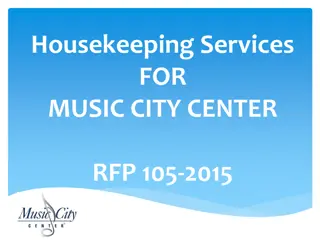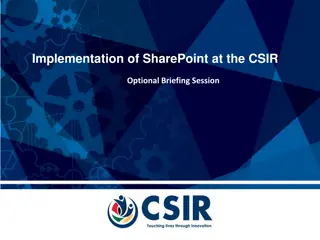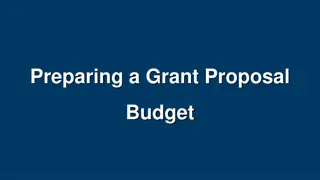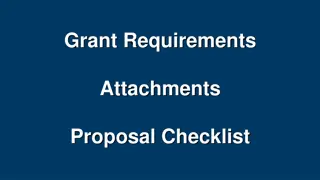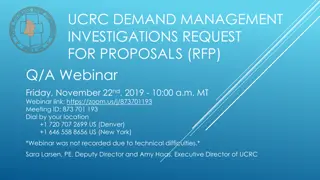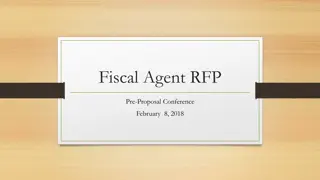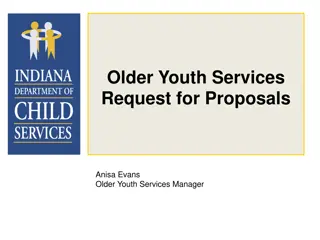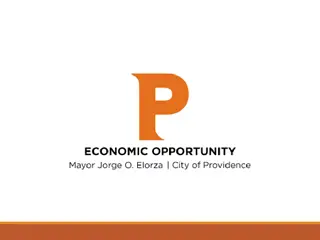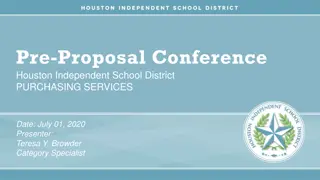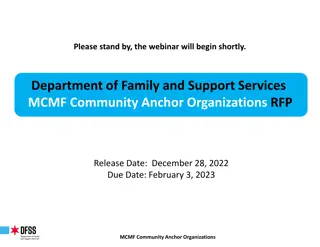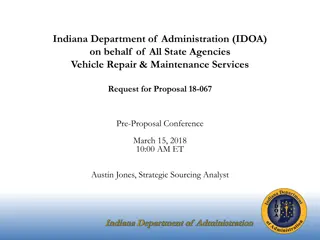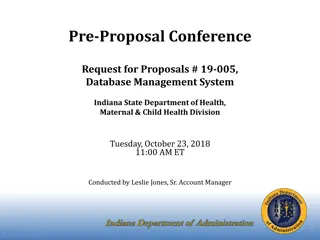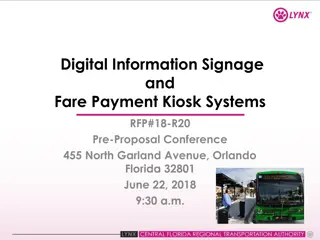Creating a Successful RFP for a New Data System
Explore key insights and strategies for developing a comprehensive Request for Proposal (RFP) process to procure a new data system. Learn from experienced presenters about the critical aspects of RFP creation, challenges faced, and best practices for ensuring a successful outcome. This session aims to provide valuable knowledge and practical tips for anyone involved in the RFP process within early childhood data systems.
Download Presentation

Please find below an Image/Link to download the presentation.
The content on the website is provided AS IS for your information and personal use only. It may not be sold, licensed, or shared on other websites without obtaining consent from the author.If you encounter any issues during the download, it is possible that the publisher has removed the file from their server.
You are allowed to download the files provided on this website for personal or commercial use, subject to the condition that they are used lawfully. All files are the property of their respective owners.
The content on the website is provided AS IS for your information and personal use only. It may not be sold, licensed, or shared on other websites without obtaining consent from the author.
E N D
Presentation Transcript
The Center for IDEA Early Childhood Data Systems What does it Take to Create a Good RFP for a New Data System? Bruce Bull Jamie Kilpatrick 2016 Improving Data, Improving Outcomes Conference New Orleans, LA August 2016
Presenters Bruce Bull, DaSy, CIID, SPEDSIS Jamie Kilpatrick, DaSy, PCG Experience: Higher Education, State Government, TA Providers, For Profit Business 2
Description / Overview Session Description: A single session support group for those who experience (or might in the future) RFP-itis. Is there a RFP for a data system in your state's future? Learn from the experiences (thumbs up and down) of TA providers with both state agency and contractor backgrounds. Audience will also be encouraged to share their lessons learned. 3
Session Expectations Share stories: Yours and Ours What we know (or think we know) Share land mines: Didn t see ___. What worked for us . . . What we d do differently next time . . . Where to go for help 4
Audience Your roles? Your RFP experience? 5
RFP and DaSy Framework Connection System Design and Development Subcomponent 1: Initiation of New System/Enhancement and Requirements Analysis Subcomponent 2: System Design and Development Subcomponent 3: System Acceptance and Deployment Main takeaway #1 6
RFP to Secure a Create Solution RFP should focus on the end, not the means Main takeaway #2 7
Agenda RFP defined RFP content RFP development RFP challenges 8
RFPRequest for Proposal RFP is a solicitation to potential suppliers for a commodity or service. RFPs often request: technical expertise specialized capability/product develop new service/product 9
(RFIRequest for Information) RFI is a solicitation to potential suppliers to gather information to inform next steps. RFIs often precede an RFP. 10
RFP New Data System Content What do you think should be included? 11
High Level RFP Content Boiler plate Background information Budget and timelines Desired functionality Evaluation factors Data system RFP content 12
Boiler Plate (agency lawyer speak) Procurement will provide some contractual language BUT READ IT!! There is content you can t change, but often you can change some, (though colleagues might say you can t) Ask procurement, How can we ____? 13
Work WITH Procurement Write as much flexibility as possible into the RFP things inevitably change. Consider pros and cons of scoring criteria by section. Secure examples of good data system RFPs; your agency AND other agencies. Talk with and learn from others. 14
Within Your State Study copies of other agency data system RFPs Ask questions of other agency project managers about processes used (RFP writing, project management, etc.) Study copies of final contracts 15
Ask Other States Copies of their data system RFPs Amounts of final contracts For copies of final contracts Copies of submitted proposals Satisfaction with vendor How vendor resolves problems List of responding vendors, so you can notify as many qualified proposers as possible 16
Background Information Briefly describe Reason for new data system (e.g., federal and state reporting) Connections to other systems and work of agency User levels and high level functions 17
Background Information Reference applicable parts of DaSy Data System Framework within the RFP 18
Budget (Realistic) Get costs from other states Compare apples to apples (e.g., hosting, level of support, training) Secure adequate fiscal resources Budget for updates, maintenance Include maximum amount available in RFP? 19
Budget Cont Request a bank of hours (agency controls) and vendor includes in fixed price for features not in RFP Establish amount/hr to support work, as needed, not in RFP 20
Desired Functionality Too much detail can result in bidders who simply deliver to your specification without thinking strategically. Overly detailed lists discourage vendors from offering their best approach and can lock you into particular solutions or approaches. If you (or IT) insists on a specific collection of web tools, you risk missing better solutions. Edited from: www.fivepaths.com/resources/writing-request-proposal 21
Evaluation Factors One of many configurations and assignments of points x factors. 22
Evaluation Factors Cont Clear description of factors, what is being sought Assign points to factors based on what is important Is there a preferred vendor? Establish sensible criteria 23
Evaluation Factors Cont Cost points are (usually) proportional Max cost points to lowest bidder All other bidders receive proportional Technical Points Think through scoring criteria and review process Technical points vs cost proportion 24
Review Process Select qualified reviewers. Train reviewers. Don t assume they know. Encourage point spread Practice Calibrate (reach high interrater reliability) Score individually Meet to discuss, as things get missed 26
New Data System RFP Content What would you include? Technical requirements Security, back up Data integration Environments (vendor, cloud, agency, dev, test, etc.) User roles and functions 27
New Data System RFP Content Cont Technical Requirements (con t) Important timelines (annual agency list, start dates) Functional requirements by users Business rules/logic 28
New Data System RFP Content Cont Within RFP describe role of agency IT: Project management Decision making Acceptance testing (Helpful for vendors to know, critical for program staff to know.) 29
New Data System RFP Content Cont Training requirements Documentation requirements Expected response time for bug fixes Agency FTE commitment to project management (Plan for it!) Onsite work and technical access 30
New Data System RFP Content Cont Previous system docs (as applicable) Documents supporting importance of data system (e.g., APR, SSIP) References to agency expectation to system development life cycle Process and data models 31
New Data System RFP Content Cont Schedule of implementation Stakeholder input processes 32
Time needed to write RFP 1-2 years Political/fiscal acceptance, THEN 1 year to write RFP (Even if building data system internally, 1 year to develop requirements and specifications) You may have to build the business case to establish the (RFP) solution 33
Time for tasks OTHER THAN writing RFP IT review Procurement review Rewriting RFP Set point criteria Post RFP RFP question and answer period Train proposals readers Proposal scoring Best and final offer Contracting Other 34
What we like to see1 IT Role defined and not cumbersome. There is a reason new system is not being developed in house. When IT suggests how a vendor must ask, How does that solution support what is best for our program? 35 1 Bruce and Jamie talking, not TA Center sanctioned.
Challenges? Shout out your RFP challenges. 36
Challenges weve Experienced Incomplete RFPs not ready RFPs without champion stuck in bureaucracy Failure to ask the right procurement people the right questions 37
Challenges weve Experienced Unnecessary page limitations Too much canned response required (to satisfy boiler plate) RFP too directive: how to focus not desired functionality focussed 38
Challenges weve Experienced Poor point values for sections Overlapping/redundant section content (E.g., Qualifications AND Experience sections.) 39
Challenges weve Experienced Assume work ends with vendor selection. (Not budgeting enough agency time = poor project management = tyranny of the urgent) Unrealistic Time Lines To develop RFP To respond to RFP To meet RFP deliverables 40
Audience RFP Experience Who has created an RFP for a new data system? How long did it take? What kind of TA did you get WHEN WRITING? From whom did you get it? What would you different next time? 41
Miscellaneous Sole sourcing Other? 42
Questions / Contact Hmms, buts, whats, and duhs Bruce Bull Bruce.Bull@SPEDSIS.com Jamie Kilpatrick - jkilpatrick@pcgus.com 43
How to Stay in Touch with DaSy Visit the DaSy website at: http://dasycenter.org/ Like us on Facebook: https://www.facebook.com/dasycenter Follow us on Twitter: @DaSyCenter 44
The contents of this presentation were developed under a grant from the U.S. Department of Education, # H373Z120002. However, those contents do not necessarily represent the policy of the U.S. Department of Education, and you should not assume endorsement by the Federal Government. Project Officers, Meredith Miceli and Richelle Davis. 45


